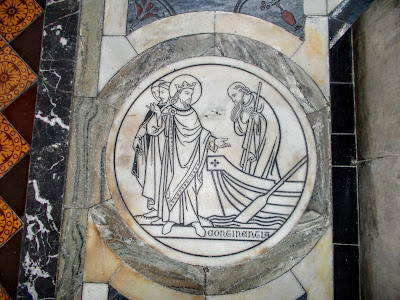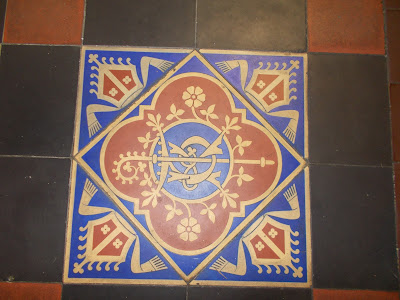St John the Baptist Church in Frome is well worth a visit, as it contains a large number of interesting features.
The first church on the site was a Saxon one made of wood and founded by St Aldhelm in 685AD. His mission was to bring Christianity to the wild and barbaric tribes who inhabited Selwood Forest. His church was replaced by a stone one, which was then in turn replaced by a Norman church in the 12th century. The Norman church was extended several times until it reached its current footprint in around 1420.
By the mid 1800s the church had become very dilapidated and it was extensively modernised in the Anglo-Catholic style in the Victorian period by WJE Bennett, who was Vicar of St John's from 1852 to 1886. The stained glass windows in the Lady Chapel and the north and south aisles date from this time and were the work of C.E. Kempe & Co.
The St Nicholas Chapel was built in 1408 as a Chantry Chapel. It is now the baptistry. The font dates from the 13th century and the tall wooden cover was made for it in 1884. The Seven Virtues and Seven Deadly sins are depicted in marble on the floor around the font.
A Via Crucis (Way of the Cross) was designed and sculpted by James Forsyth as a processional way from the street up to the north porch of St John's Church. It was erected in 1866 and features scenes from the trial and crucifixion of Jesus.
Thomas Ken was appointed Bishop of Bath and Wells by King Charles II in 1684. He lived a holy and austere life and wrote manuals of prayers and several hymns. He cared for the poor and regularly shared his Sunday lunch with 12 poor men and women. After the death of Charles II, Bishop Ken swore allegiance to James II. He then set up charity schools in the larger towns in the diocese with Lord Weymouth. After the Monmouth Rebellion he remonstrated with Judge Jeffries about the treatment of the captured rebels. He was sent to the Tower of London in 1688 for seditious libel because he had preached against James II's Declaration of Indulgence, which suspended the laws against Roman Catholics and Protestant dissenters. When James II fled from England, Bishop Ken refused to swear an oath of allegiance to William, as he felt that he could not break his existing oath to James II. He had to leave his job and spent the rest of his life living at Longleat with Lord Weymouth. He was buried at St John's Church in Frome because at that time it was the closest parish church to Longleat that was in the Diocese of Bath and Wells.
Font with the Seven Virtues around it
Zeal - the Wise Virgins
Contentment - Barzillai & David
Greed - the Rich Man
St John the Baptist Church, Frome
St John the Baptist Church, Frome
In 1990 stained glass artist, Mark Angus was commissioned to make a stained-glass window of a historical timeline commemorating important events in Britain since 597. The events illustrated are from bottom to top:
- 597 St Augustine lands in Kent
- 685 St Aldhelm establishes the first church in Frome (the town is depicted with as a red heart with the River Frome running through it).
- 1066 Norman Conquest of Britain
- 1349 The Black Death
- 1536 Dissolution of the Monasteries by Henry VIII
- 1914-1918 First World War
- 1939-1945 Second World War
- 1945 The Atom Bomb (mushroom cloud)
- 1985 After 1300 years St Aldhelm's Church is still shining the light of the Gospel
























No comments:
Post a Comment